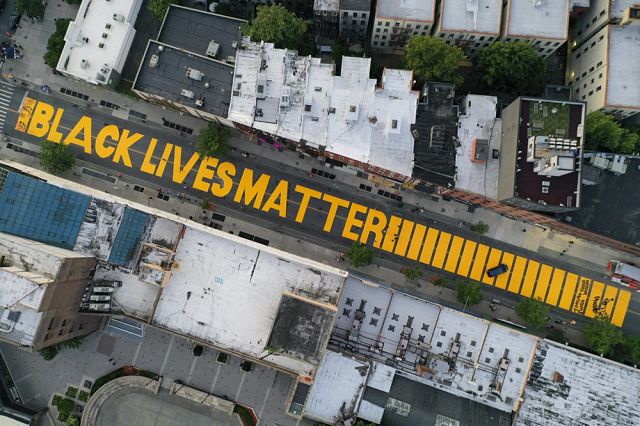 A giant "BLACK LIVES MATTER" sign is painted in orange on Fulton Street, Monday, June 15, 2020, in the Brooklyn borough of New York. Black Lives Matter Global Network Foundation has established a more than $12 million fund to aid organizations fighting institutional racism in the wake of the George Floyd protests. (AP Photo)
A giant "BLACK LIVES MATTER" sign is painted in orange on Fulton Street, Monday, June 15, 2020, in the Brooklyn borough of New York. Black Lives Matter Global Network Foundation has established a more than $12 million fund to aid organizations fighting institutional racism in the wake of the George Floyd protests. (AP Photo)
The Associated Press
NEW YORK (AP) — The Black Lives Matter Global Network Foundation has established a fund worth more than $12 million to aid organizations fighting institutional racism, in the wake of the George Floyd protests.
On Wednesday, the foundation, which has been influential in the emergence of the broader Black Lives Matter movement, said it was setting aside $6 million in donations to support black-led grassroots organizing groups. Last week, it unveiled a separate $6.5 million fund for its network of affiliate chapters.
Beginning July 1, affiliated chapters can apply for unrestricted funding of up to $500,000 in multi-year grants, the foundation announced. Grants from both funds will be administered through a fiscal sponsor, said Kailee Scales, managing director of the foundation.
“In this watershed moment for black power building … it is critical that we democratize giving to ensure all of us have access to the resources we need to reverse centuries of disinvestment in black communities, and invest in a future where we can all be connected, represented and free,” Scales said in a statement to The Associated Press.
According to the network’s website, the organization has more than a dozen active chapters, including Boston, Chicago, Washington, D.C., and Detroit, as well as in Canada. Its newest chapter is in South Bend, Indiana.
The foundation told the AP it has received more than 1.1 million individual donations at an average of $33 per gift since the death of Floyd, a black man who died May 25 pleading for air as a white Minneapolis police officer held a knee to his neck for what prosecutors said was nearly nine minutes. The surge of financial support adds to roughly $3.4 million in net assets the BLM global network had on hand last year, according to a 2019 financial statement of Thousand Currents, the fiscal sponsor which receives donations on the network’s behalf and then releases money to the group.
Creation of the funds signals a growth in infrastructure for the network, which had been at odds with some local chapter organizers, who felt network leaders weren’t providing enough financial support for initiatives such as rapid response to police brutality. Although there are many groups that use “Black Lives Matter” or “BLM” in their names, only 16 are considered affiliates of the global network.
For Black Lives Matter Los Angeles, the network’s first official chapter, the fund will increase its capacity to support families in need of legal aid, public communications strategy and other services after a loved one is killed by police, said organizer Melina Abdullah, who is a professor in the Pan-African Studies department at California State University, Los Angeles.
“We’ve been struggling for seven years now with very limited resources,” Abdullah told the AP. “We’re not paid. But we also have real costs, even if we’re not taking salaries.”
Renewed energy in the BLM movement has created a need for more resources, she added. “This fund will allow us to move forward in really strong ways.”
Racial justice groups across the U.S. have reported receiving tens of millions of dollars in donations, particularly for community bail funds posting bond for protesters arrested in demonstrations. The wealth is being spread across younger grassroots organizations and legacy institutions, such as the NAACP Legal Defense and Education Fund and the National Urban League.
The Black Lives Matter movement emerged in 2013 amid anger over the acquittal of George Zimmerman, the Florida man who shot and killed 17-year-old Trayvon Martin in 2012. The network of chapters was formed in 2014, following what organizers called Ferguson October, a national mobilization in response to the police shooting death of 18-year-old Michael Brown in Ferguson, Missouri.
“I’m really proud of the work we’ve been able to do in the last seven years,” Patrisse Cullors, co-founder and chairwoman of the Black Lives Matter Global Network Foundation, said in a statement. “What is clear is that Black Lives Matter shares a name with a much larger movement and there are literally hundreds of organizations that do impactful racial and gender justice work who make up the fabric of this broader movement.”
—
Photos: Ethiopians Show Solidarity with Black Lives Matter in D.C.
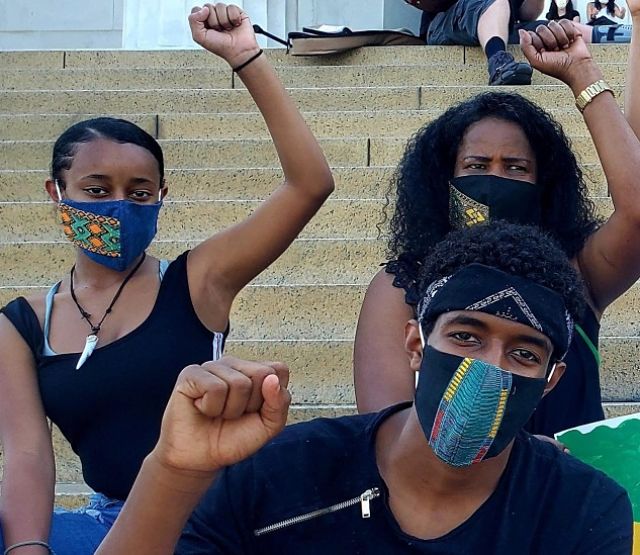
Last week Ethiopian-Americans marched from the State Department to the Lincoln Memorial in Washington, D.C. to express solidarity with the Black Lives Matter movement and to demand justice for George Floyd and other victims of police brutality. (Photo by Teshalech Adot Ega)
Tadias Magazine
By Tadias Staff
Updated: June 17th, 2020
New York (TADIAS) – In a matter of weeks the Black Lives Matter movement has gone mainstream with its own street name painted in huge yellow letters right across from the White House in Washington, D.C. As the Associated Press noted: “Now, Black Lives Matter Plaza turns up in driving directions from Google Maps.”
Last week Ethiopian-Americans marched from the State Department to the Lincoln Memorial to express solidarity with the Black Lives Matter movement and to demand justice for George Floyd and other victims of police brutality.
Describing the formation of Black Lives Matter AP adds: “a coalition known as the Movement for Black Lives, formed in 2014, now includes more than 150 affiliate organizations that have organized around such causes as defunding police departments and reinvesting in struggling black communities. Its agenda focuses heavily on overhauling police training, the use of force and the punishment of rogue officers. The movement is also pressing to erase economic inequality and disparities in education and health care.”
Below are photos from Matt Andrea and related news stories:
—-
Pictures From Protests Across America (UPDATE)
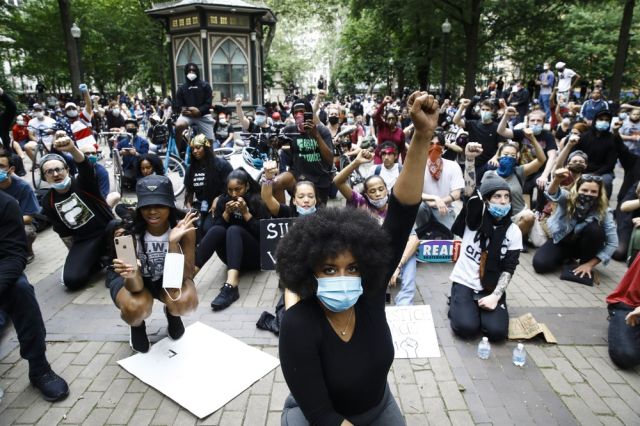
Demonstrators chant Tuesday, June 2, 2020, at Rittenhouse Square in Philadelphia, during a protest over the death of George Floyd, who died May 25 after he was restrained by Minneapolis police. (AP Photo)
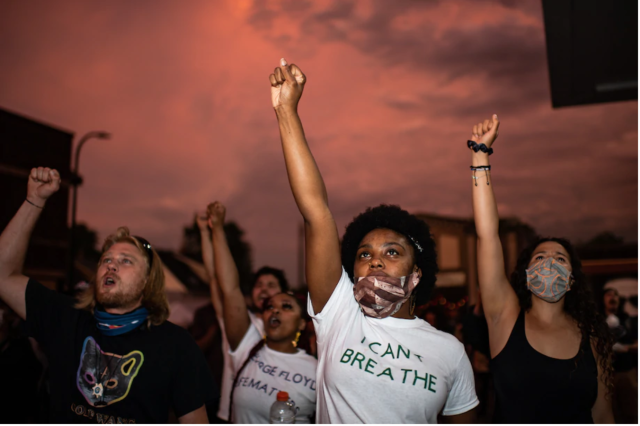
Protesters chant, “Say his name, George Floyd,” near a memorial for Floyd on June 2 in Minneapolis. (The Washington Post)
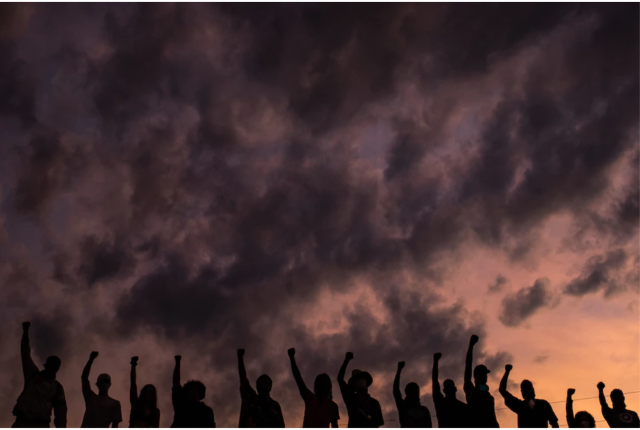
Protesters gather near a memorial for George Floyd at the intersection of 38th Street and Chicago Avenue on June 2 in Minneapolis. (The Washington Post)
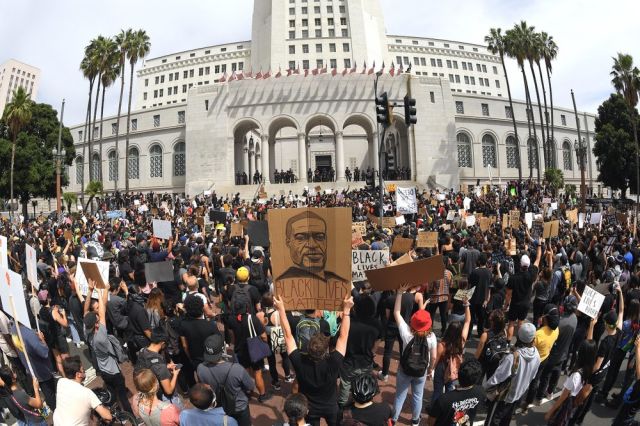
In this photo taken with a wide angle lens, demonstrators stand in front of Los Angeles City Hall during a protest over the death of George Floyd Tuesday, June 2, 2020, in Los Angeles. Floyd died in police custody on Memorial Day in Minneapolis. (AP Photo)
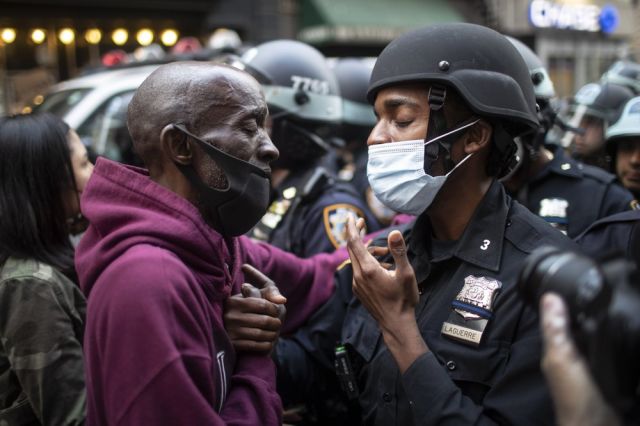
A protester and a police officer shake hands in the middle of a standoff during a solidarity rally calling for justice over the death of George Floyd Tuesday, June 2, 2020, in New York. Floyd died after being restrained by Minneapolis police officers on May 25. (AP Photo)
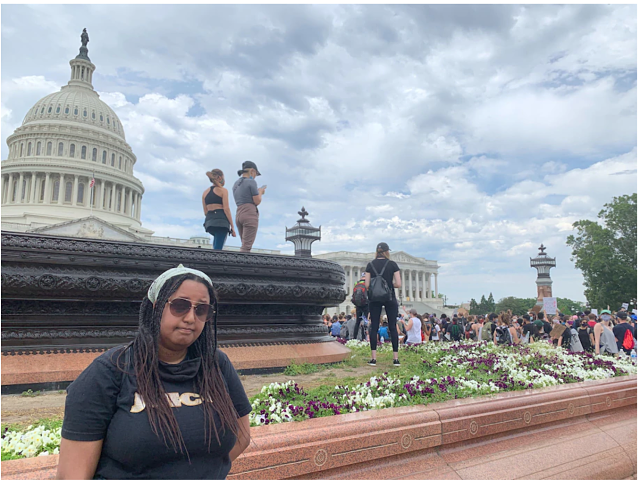
Abby Belai, 26, of Falls Church attended the protest at the U.S. Capitol in Washington, D.C. on Wednesday, June 3rd, 2020. Abby, whose parents moved to the United States from Ethiopia before she was born, said she felt compelled to be at the protest to show support for the generations of black Americans who had suffered and battled for their constitutional rights. “I worry for the children that see this stuff on TV and see their parents get racially profiled,” said Belai, 26, of Falls Church. “This shouldn’t continue for future generations, and we won’t stop until we are heard and seen and understood and accepted just like every person in this country and in the world.” (TWP)
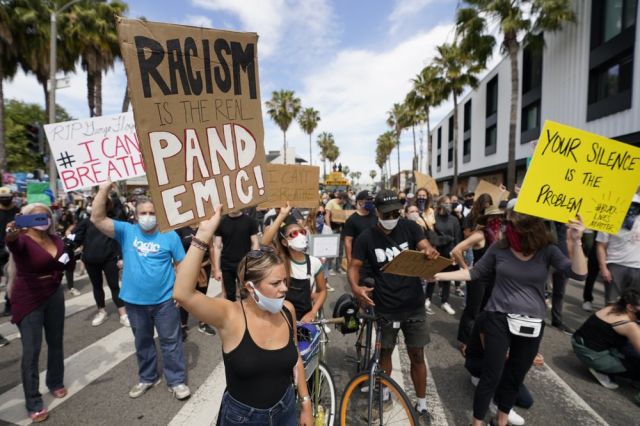
Demonstrators hold up signs Tuesday, June 2, 2020, in the Venice Beach area of Los Angeles during a protest over the death of George Floyd. Floyd died in police custody on May 25 in Minneapolis. (AP Photo)
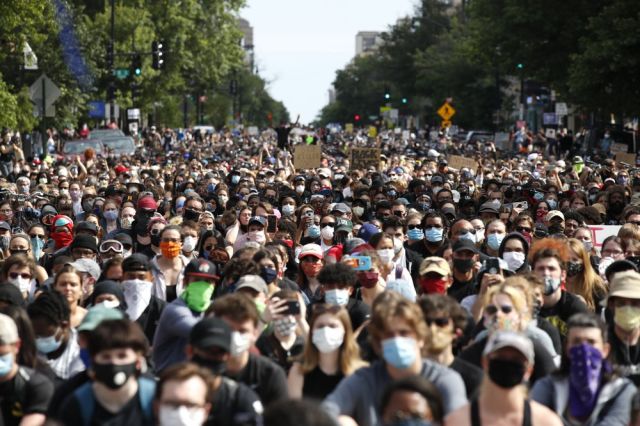
Demonstrators pause to kneel as they march to protest the death of George Floyd, Tuesday, June 2, 2020, in Washington. Floyd died after being restrained by Minneapolis police officers. (AP Photo)
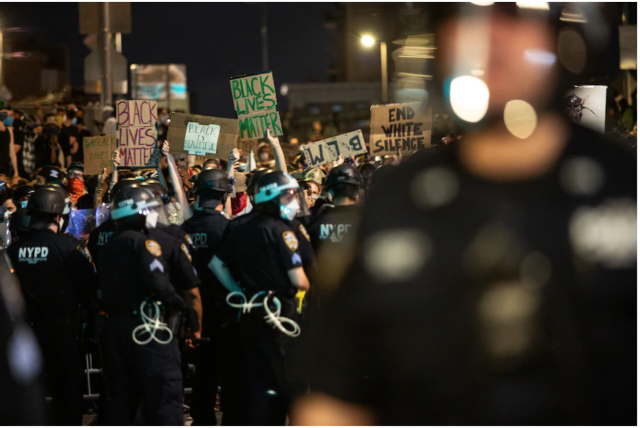
Protesters from Brooklyn attempt to cross the Manhattan Bridge after the 8 p.m. curfew imposed by New York Mayor Bill de Blasio (D) but were blocked by police on June 2. (The Washington Post)
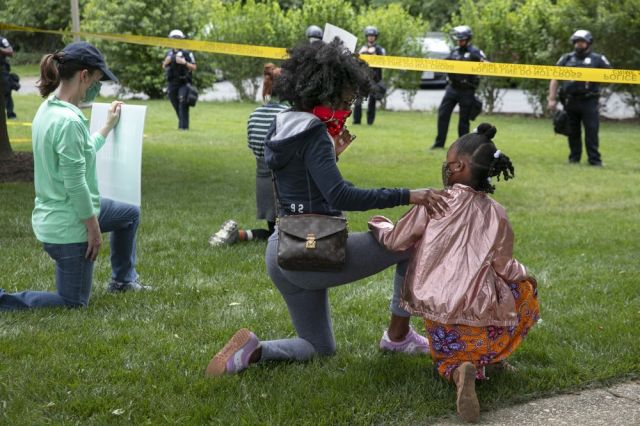
Ericka Ward-Audena, of Washington, puts her hand on her daughter Elle Ward-Audena, 7, as they take a knee in front of a police line during a protest of President Donald Trump’s visit to the Saint John Paul II National Shrine, Tuesday, June 2, 2020, in Washington. “I wanted my daughter to see the protests, it’s really important. I’ve gotten a million questions from her because of it,” says Ward-Audena, “I think the most egregious statement was ‘when they start looting, we start shooting.’ That crossed a line for me.” Protests continue over the death of George Floyd, who died after being restrained by Minneapolis police officers. (AP Photo)
—
How the Black Lives Matter Movement Went Mainstream
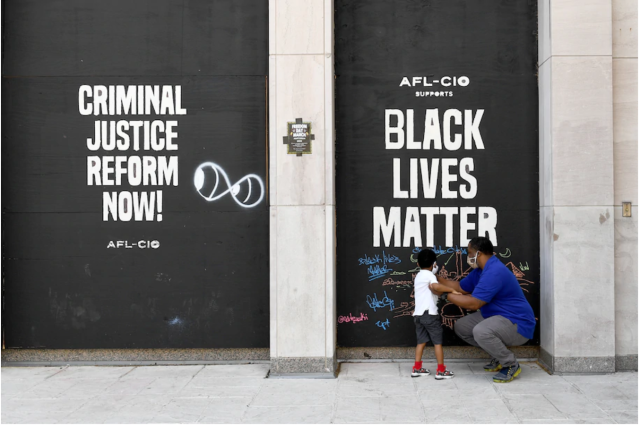
A father shows his son the writing on the walls around the newly renamed Black Lives Matter Plaza near the White House on Sunday. (The Washington Post)
The Washington Post
The three words were once a controversial rallying cry against racial profiling and police violence. Now, “Black lives matter” is painted in bright yellow letters on the road to the White House. Celebrities and chief executives are embracing it. Even Sen. Mitt Romney, a Republican former presidential candidate, posted the phrase on Twitter.
As consensus grows about the existence of systemic racism in American policing and other facets of American life, longtime organizers of the Black Lives Matter movement are trying to extend its momentum beyond the popularization of a phrase. Activists sense a once-in-a-generation opportunity to demand policy changes that once seemed far-fetched, including sharp cuts to police budgets in favor of social programs, and greater accountability for officers who kill residents.
“It’s now something where the Mitt Romneys of the world can join in, and that was something unimaginable back in 2014. That is the result of six years of hard work by people who are in the movement and have put forward so many discussions that really changed people’s hearts and minds,” said Justin Hansford, who was an activist in Ferguson, Mo., during the unrest after the police killing of an unarmed black teen there. He is now the executive director of the Thurgood Marshall Civil Rights Center at Howard University.
But activists’ demands to “defund” police departments have already become a point of division politically, with some prominent people who have expressed support for the movement — such as Romney (Utah) — saying they do not support what they see as an extreme policy position. President Trump has already suggested that his presumed Democratic opponent, former vice president Joe Biden, would be forced to cut funding to police under pressure from the left, even though Biden has also said he does not support defunding the police.
Where the conversation lands will be a test of just how mainstream Black Lives Matter has become.
—
Calls For Police Reforms Gain Momentum as Protests Continue Across U.S.
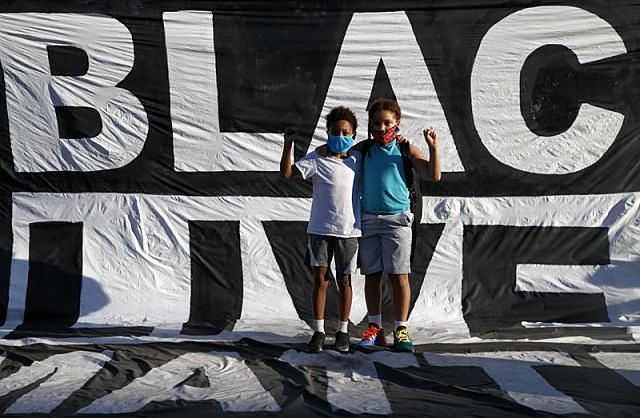
Two young brothers from Frederick, Maryland, stand on the Black Lives Matter banner that is draped on the fence surrounding Lafayette Park, for a photograph as they attend a protest Sunday, June 7, 2020, near the White House in Washington over the death of George Floyd, who died May 25 after being restrained by police in Minneapolis. (AP Photo)
The Associated Press
June 8th, 2020
Police Back Off as Peaceful Protests Push Deep Reforms
Calls for deep police reforms gained momentum as leaders in the city where George Floyd died at the hands of an officer pushed to dismantle the entire department.
Floyd’s death sparked nationwide protests demanding a reckoning with institutional racism that have sometimes resulted in clashes with police, but many officers took a less aggressive stance over the weekend when demonstrations were overwhelmingly peaceful.
Two weeks after Floyd, an out-of-work black bouncer, died after a white Minneapolis officer pressed a knee on his neck for several minutes, a majority of the Minneapolis City Council vowed to dismantle the 800-member agency.
“It is clear that our system of policing is not keeping our communities safe,” City Council President Lisa Bender said Sunday. “Our efforts at incremental reform have failed, period.”
It’s not the first time an American city has wrestled with how to deal with a police department accused of being overly aggressive or having bias in its ranks. In Ferguson, Missouri — where a white officer in 2014 fatally shot Michael Brown, a black 18-year-old — then-Attorney General Eric Holder said federal authorities considered dismantling the police department. The city eventually reached an agreement short of that but one that required massive reforms.
The state of Minnesota has launched a civil rights investigation of the Minneapolis Police Department, and the first concrete changes came when the city agreed to ban chokeholds and neck restraints.
On Sunday, nine of the Minneapolis City Council’s 12 members vowed to end policing as the city currently knows it. Mayor Jacob Frey said he doesn’t support the “full abolition” of the department.
Protesters nationwide are demanding police reforms and a reckoning with institutional racism in response to Floyd’s death, and calls to “defund the police” have become rallying cries for many. A heavy-handed response to demonstrations in many places has underscored what critics have maintained: Law enforcement is militarized and too often uses excessive force.
Cities imposed curfews as several protests last week were marred by spasms of arson, assaults and smash-and-grab raids on businesses. More than 10,000 people have been arrested around the country since protests began, according to reports tracked by The Associated Press. Videos have surfaced of officers in riot gear using tear gas or physical force against even peaceful demonstrators.
But U.S. protests in recent days have been overwhelmingly peaceful — and over the weekend, several police departments appeared to retreat from aggressive tactics.
Several cities have also lifted curfews, including Chicago and New York City, where the governor urged protesters to get tested for the virus and to proceed with caution until they had. Leaders around the country have expressed concern that demonstrations could lead to an increase in coronavirus cases.
For the first time since protests began in New York more than a week ago, most officers Sunday were not wearing riot helmets as they watched over rallies. Police moved the barricades at the Trump hotel at Columbus Circle for protesters so they could pass through.
Officers in some places in the city casually smoked cigars or ate ice cream and pizza. Some officers shook hands and posed for photos with motorcyclists at one rally.
In Compton, California, several thousand protesters, some on horseback, peacefully demonstrated through the city, just south of Los Angeles. The only law enforcement presence was about a dozen sheriff’s deputies, who watched without engaging.
In Washington, D.C., National Guard troops from South Carolina were seen checking out of their hotel Sunday shortly before President Donald Trump tweeted he was giving the order to withdraw them from the nation’s capital.
Things weren’t as peaceful in Seattle, where the mayor and police chief had said they were trying to deescalate tensions. Police used flash bang devices and pepper spray to disperse protesters after rocks, bottles and explosives were thrown at officers Saturday night. On Sunday night, a man drove a car at protesters, hit a barricade then exited the vehicle brandishing a pistol, authorities said. A 27-year-old male was shot and taken to a hospital in stable condition, the Seattle Fire Department said.
Dual crises — the coronavirus pandemic and the protests — have weighed particularly heavily on the black community, which has been disproportionately affected by the virus, and also exposed deep political fissures in the U.S. during this presidential election year.
Trump’s leadership during both has been called into question by Democrats and a few Republicans who viewed his response to COVID-19 as too little, too late, and his reaction to protests as heavy handed and insensitive.
On Sunday, U.S. Sen. Mitt Romney of Utah marched in a protest in Washington against police mistreatment of minorities, making him the first known Republican senator to do so.
“We need a voice against racism, we need many voices against racism and against brutality,” Romney, who represents Utah, told NBC News.
On Sunday, Floyd’s body arrived in Texas for a third and final memorial service, said Houston Police Chief Art Acevedo. A viewing is planned for Monday in Houston, followed by a service and burial Tuesday in suburban Pearland.
___
Black Lives Matter Protests for U.S. Racial Justice Reach New Dimension
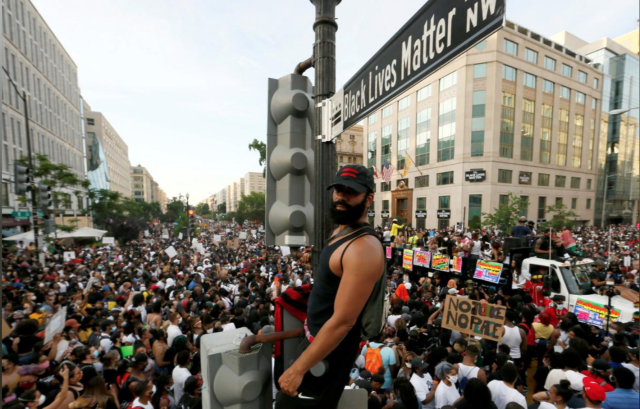
Protesters at the newly named Black Lives Matter Plaza in Washington, D.C. near the White House on June 6, 2020. (Reuters)
Reuters
WASHINGTON (Reuters) – U.S. protests sparked by George Floyd’s fatal encounter last month with Minneapolis police crossed a new threshold as weekend rallies demanding racial justice stretched from Washington, D.C., to an east Texas town once a haven for the Ku Klux Klan.
They also inspired anti-racism protests around the globe, as demonstrators from Brisbane and Sydney in Australia to London, Paris and other European cities embraced the Black Lives Matter message.
In Washington, tens of thousands of people chanting “I can’t breathe” and “Hands up, don’t shoot” rallied at the Lincoln Memorial and marched to the White House on Saturday in the biggest protest yet during 12 days of demonstrations across the United States since Floyd died.
A common message of the day was a determination to transform outrage generated by Floyd’s death into a broader movement seeking far-reaching reforms in the U.S. criminal justice system and its treatment of minorities.
“It feels like I get to be a part of history and a part of people who are trying to change the world for everyone,” said Jamilah Muahyman, a Washington resident protesting near the White House.
The gatherings in Washington and dozens of other U.S. cities and towns – urban and rural alike – were also notable for a generally lower level of tension and discord than what was seen during much of the preceding week.
There were sporadic instances in some cities of protesters trying to block traffic. And police in riot gear used flash-bang grenades in a confrontation with demonstrators in Seattle.
But largely it was the most peaceful day of protests since video footage emerged on May 25 showing Floyd, an unarmed black man in handcuffs, lying face down on a Minneapolis street as a white police officer knelt on his neck.
The video sparked an outpouring of rage as protests in Minneapolis spread to other cities, punctuated by episodes of arson, looting and vandalism that authorities and activists blamed largely on outside agitators and criminals.
National Guard troops were activated in several states, and police resorted to heavy-handed tactics in some cities as they sought to enforce curfews imposed to quell civil disturbances, which in turn galvanized demonstrators even further.
The intensity of protests over the past week began to ebb on Wednesday after prosecutors in Minneapolis had arrested all four police officers implicated in Floyd’s death. Derek Chauvin, the white officer seen pinning Floyd’s neck to the ground for nearly nine minutes as Floyd repeatedly groaned “I can’t breathe” was charged with second-degree murder.
On Sunday morning, New York Mayor Bill de Blasio announced he was lifting a citywide curfew a day early.
Still, anger in Minneapolis remained intense. The city’s mayor ran a gauntlet of angry, jeering protesters on Saturday after telling them he was opposed to their demands for de-funding the city police department.
Perhaps nowhere was the evolving, multi-racial dimension of the protests more evident than in the small, east Texas town of Vidor, one of hundreds of American communities known decades ago as “sundown towns” because blacks were unwelcome there after dark.
Several dozen white and black protesters carrying “Black Lives Matter” signs demonstrated on Saturday in Vidor, once notorious as a Ku Klux Klan stronghold, highlighting the scope of renewed calls for racial equality echoing across the country five months before the Nov. 3 U.S. presidential election.
Elsewhere in the South, in Floyd’s birthplace of Raeford, North Carolina, hundreds lined up at a church to pay their respects during a public viewing of his body prior to a private memorial service for family members.
Floyd’s funeral is scheduled for Tuesday in Houston, where he lived before relocating to the Minneapolis area.
In New York, a large crowd of protesters crossed the Brooklyn Bridge into lower Manhattan on Saturday afternoon, marching up a largely deserted Broadway. Thousands of others gathered in Harlem to march downtown, about 100 blocks, to the city’s Washington Square Park.
Police officers were present but in smaller numbers than earlier in the week. They generally assumed a less aggressive posture, wearing patrol uniforms rather than body armor and helmets.
In another sign of easing tension, Major General William Walker, commander of the D.C. National Guard, told CNN that the nearly 4,000 additional Guard troops deployed to the city from 11 states at the Pentagon’s request were likely to be withdrawn after the weekend.
—
George Floyd live updates: Protests grow, even spreading to notorious Texas town with racist history
As George Floyd was mourned near his birthplace in North Carolina on Saturday, crowds filled the streets in American cities large and small with protests against police brutality and systemic racism that continued to grow.
In California, demonstrators brought traffic to a halt on the Golden Gate Bridge. In Philadelphia, thousands massed in the streets as the mayor and the police commissioner knelt in a show of solidarity. A rally in Chicago drew an estimated 30,000 people. In Washington, D.C., some protesters furiously spray-painted “Defund The Police” in giant yellow letters a block from the city’s “Black Lives Matter” display..
The demonstrations, which researchers call the broadest in U.S. history, even spread to Vidor, Tex., a notorious “sundown town” with a racist history, including Ku Klux Klan activity.
—
Protesters Flood U.S. Streets in Huge, Peaceful Push for Change (UPDATE)
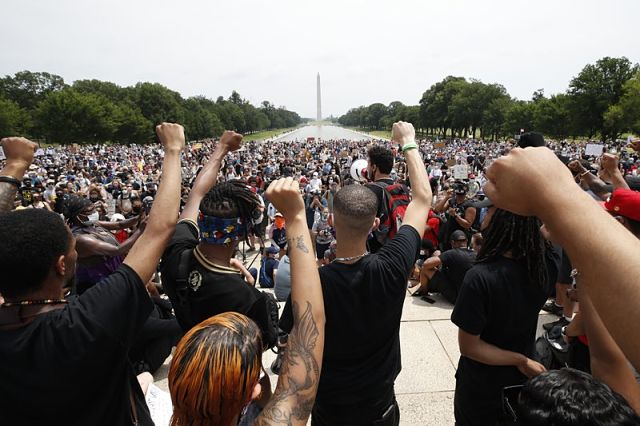
Demonstrators protest Saturday, June 6, 2020, at the Lincoln Memorial in Washington, over the death of George Floyd, a black man who was in police custody in Minneapolis. Floyd died after being restrained by Minneapolis police officers. (AP Photo)
The Associated Press
Tens of thousands of protesters streamed into the nation’s capital and other major cities Saturday in another huge mobilization against police brutality and racial injustice, while George Floyd was remembered in his North Carolina hometown by mourners who waited hours for a glimpse of his golden coffin.
Wearing masks and calling for police reform, protesters peacefully marched across the U.S. and on four other continents, collectively producing perhaps the largest one-day mobilization since Floyd’s death 12 days ago at the hands of police in Minneapolis.
The dozens of demonstrations capped a week of nearly constant protests that swelled beyond anything the nation has seen in at least a generation. After frequent episodes of violence following the black man’s death, the crowds in the U.S. shifted to a calmer tenor in recent days and authorities in many cities began lifting curfews because they experienced little unrest and no arrests.
On Saturday, authorities in some places seemed to take a lower profile and protests had a festive feel.
On a hot, humid day in Washington, throngs of protesters gathered at the Capitol, on the National Mall and in neighborhoods. Some turned intersections into dance floors. Tents offered snacks and water, tables with merchandise and even a snow cone station.
—
The Associated Press
Protesters Support Floyd, Black Lives Matter on 3 Continents
BERLIN (AP) — Thousands of people rallied in Australia and Europe to honor George Floyd and to voice support Saturday for what is becoming an international Black Lives Matter movement, as a worldwide wave of solidarity with protests over the death of a black man in Minneapolis highlights racial discrimination outside the United States.
Demonstrators in Paris tried to gather in front of the U.S. Embassy in Paris, defying restrictions imposed by authorities because of the coronavirus pandemic. They were met by riot police who turned people on their way to the embassy, which French security forces sealed off behind an imposing ring of metal barriers and road blocks.
“You can fine me 10,000 or 20,000 times, the revolt will happen anyway,” Egountchi Behanzin, a founder of the Black African Defense League, told officers who stopped him to check his ID documents before he got close to the diplomatic building. “It is because of you that we are here.”
Pamela Carper, who joined an afternoon protest at London’s Parliament Square that headed towards the U.K. Home Office, which oversees the country’s police, said she was demonstrating to show “solidarity for the people of America who have suffered for too long.”
The British government urged people not to gather in large numbers and police have warned that mass demonstrations could be unlawful. In England, for example, gatherings of more than six people are not permitted.
Carper said the coronavirus had “no relevance” to her attendance and noted that she had a mask on.
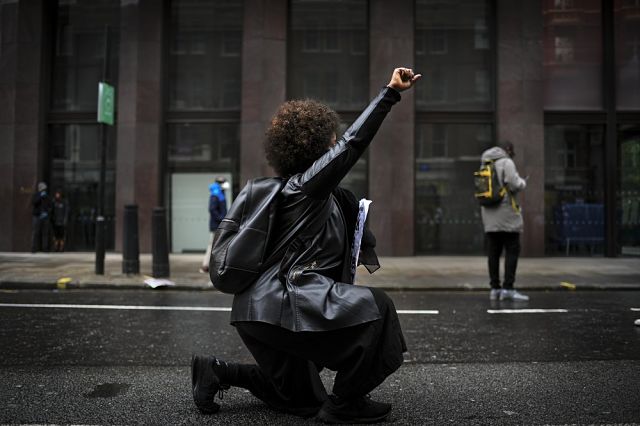
A woman kneels during a Black Lives Matter rally in London, Saturday, June 6, 2020, as people protest against the killing of George Floyd by police officers in Minneapolis, USA. Floyd, a black man, died after he was restrained by Minneapolis police while in custody on May 25 in Minnesota. (AP)
“I am showing the government that I am heeding to their rules and everybody is staying away,” Carper said. “But I need to be here because the government is the problem. The government needs to change.”
In Sydney, protesters won a last-minute appeal against a Friday ruling declaring their rally unauthorized. The New South Wales Court of Appeal gave the green light just 12 minutes before the rally was scheduled to start, meaning those taking part could not be arrested.
Up to 1,000 protesters had already gathered in the Town Hall area of downtown Sydney ahead of the decision.
Floyd, a black man, died in handcuffs on May 25 while a Minneapolis police officer pressed a knee on his neck even after he pleaded for air and stopped moving.
His death has struck a chord with minorities protesting discrimination elsewhere, including deaths of indigenous Australians in custody.
In Sydney, there was one early scuffle when police removed a man who appeared to be a counter protester carrying a sign reading, “White Lives, Black Lives, All Lives Matter.”
The rally appeared orderly as police handed out masks to protesters and other officials provided hand sanitizer.
“If we don’t die from the (coronavirus) pandemic, then we will die from police brutality,” Sadique, who has a West African background and said he goes by only one name, said in Sydney.
Bob Jones, 75, said it was worth the risk to rally for change despite the state’s chief health officer saying the event could help spread the coronavirus.
“If a society is not worth preserving, then what are you doing? You’re perpetuating a nonsense,” Jones said.
In Brisbane, the Queensland state capital, organizers said about 30,000 people gathered, forcing police to shut down some major downtown streets. The protesters demanded to have Australia’s Indigenous flag raised at the police station.
State Environment Minister Leeanne Enoch encouraged Queenslanders to speak out.
“Whether you’re talking about the U.S. or right here in Australia, black lives matter,” she said. “Black lives matter today. Black lives matter every day.”
Indigenous Australians make up 2% of the the country’s adult population, but 27% of the prison population. They are also the most disadvantaged ethnic minority in Australia and have higher-than-average rates of infant mortality and poor health, as well as shorter life expectancies and lower levels of education and employment than other Australians.
In South Korea’s capital, Seoul, protesters gathered for a second straight day to denounce Floyd’s death.
Wearing masks and black shirts, dozens of demonstrators marched through a commercial district amid a police escort, carrying signs such as “George Floyd Rest in Peace” and “Koreans for Black Lives Matter.”
“I urge the U.S. government to stop the violent suppression of (U.S.) protesters and listen to their voices,” said Jihoon Shim, one of the rally’s organizers. “I also want to urge the South Korean government to show its support for their fight (against racism).”
In Tokyo, dozens of people gathered in a peaceful protest.
“Even if we are far apart, we learn of everything instantly on social media,”
“Can we really dismiss it all as irrelevant?” Taichi Hirano, one of the organizers, shouted to the crowd gathered outside Tokyo’s Shibuya train station. He stressed that Japanese are joining others raising their voices against what he called “systematic discrimination.”
In Berlin, thousands of mostly young people, many dressed in black and wearing face masks, joined a Black Lives Matter protest in Berlin’s Alexanderplatz, or Alexander Square, on Saturday.
Some held up placards with slogans such as “Be the change,” I can’t breath” and “Germany is not innocent.”
—
Turning grief into change, movement targets racial injustice
The Associated Press
Momentum for what many hope is a sustained movement aimed at tackling racial injustice and police reforms promised to grow Saturday as more protesters filled streets around the world and mourners prepared to gather in the U.S. for a second memorial service for George Floyd, who died a dozen days ago at the hands of police in Minneapolis.
Formal and impromptu memorials to Floyd over the last several days have stretched from Minneapolis to Paris, Rome and Johannesburg, South Africa. In North Carolina, where he was born, a public viewing and private service for family was planned Saturday. Services were scheduled to culminate in a private burial in the coming days in Texas, where he lived most of his life.
Floyd’s final journey was designed with intention, the Rev. Al Sharpton said. Having left Houston for Minneapolis in 2014 in search of a job and a new life, Floyd is retracing that path in death.
Sharpton has plans for a commemorative march on Washington in August on the anniversary of the day Martin Luther King Jr. gave his “I Have a Dream” speech in 1963. He said the event would be a way to engage voters ahead of November’s general election and maintain momentum for a movement that has the power to “change the whole system of justice.”
—
D.C. Mayor Renames Street Outside White House ‘Black Lives Matter Plaza’ (UPDATE)
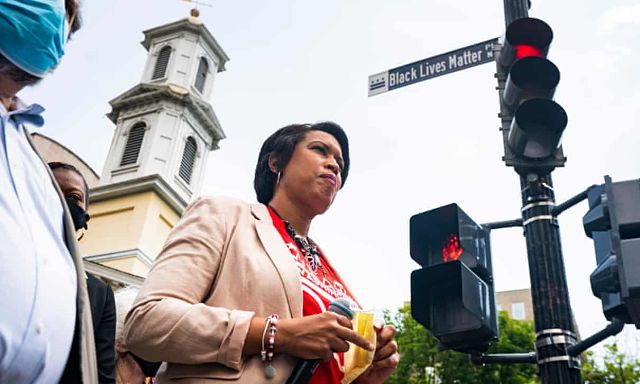
Mayor Muriel Bowser speaks after announcing that she is renaming a section of 16th street ‘Black Lives Matter Plaza’ in Washington DC on Friday. (Photograph: EPA)
The Washington Post
‘Black Lives Matter’: In giant yellow letters, D.C. mayor sends message to Trump
D.C. Mayor Muriel E. Bowser renamed a street in front of the White House “Black Lives Matter Plaza” on Friday and emblazoned the slogan in massive yellow letters on the road, a pointed salvo in her escalating dispute with President Trump over control of D.C. streets.
The actions are meant to honor demonstrators who are urging changes in police practices after the killing of George Floyd in police custody in Minneapolis, city officials said.
They come after several days of the mayor’s strong objections to the escalation of federal law enforcement and the military response to days of protests and unrest in the nation’s capital.
Local artist Rose Jaffe said she and others joined city work crews to paint the giant slogan, starting around 4 a.m.
The art will take up two blocks on 16th Street NW, between K and H streets, an iconic promenade directly north of the White House.
Shortly after 11 a.m., a city worker hung up a “Black Lives Matter Plz NW” sign at the corner of 16th and H streets NW. Bowser (D) watched silently as onlookers cheered and the song “Rise Up” by Andra Day played from speakers.
“In America, you can peacefully assemble,” Bowser said in brief remarks to the crowd.
Protests shift to memorializing Floyd amid push for change
Celebrities, musicians, political leaders and family members gathered in front of the golden casket of George Floyd at a fiery memorial Thursday for the man whose death at the hands of police sparked global protests. (AP video)
The Associated Press
The tenor of the protests set off by the death of George Floyd at the hands of police has taken a turn from the explosive anger that has fueled the setting of fires, breaking of windows and other violence to a quiet, yet more forceful, grassroots call for more to be done to address racial injustice.
Many of the protests were more subdued for a second night as marches Thursday turned into memorials for Floyd, who was the focus of a heartfelt tribute Thursday in Minneapolis that drew family members, celebrities, politicians and civil rights advocates. At his service, strong calls were made for meaningful changes in policing and the criminal justice system.
At demonstration sites around the country, protesters said the quieter mood is the result of several factors: the new and upgraded criminal charges against the police officers involved in Floyd’s arrest; a more conciliatory approach by police who have marched with them or taken a knee to recognize their message; and the realization that the burst of rage after Floyd’s death is not sustainable.
“Personally, I think you can’t riot everyday for almost a week,” said Costa Smith, 26, who was protesting in downtown Atlanta.
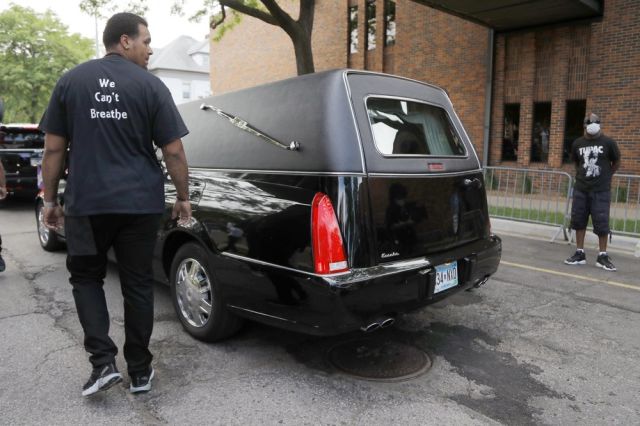
The body of George Floyd departs from Frank J. Lindquist Sanctuary at North Central University after a memorial service Thursday, June 4, 2020, in Minneapolis, Minnesota. (AP photo)
Despite the shift in tone, protesters have shown no sign that they are going away and, if anything, are emboldened to stay on the streets to push for police reforms.
In New York City, Miguel Fernandes said there were “a lot more nights to go” of marching because protesters hadn’t got what they wanted. And Floyd’s brother, Terrence, appeared in Brooklyn to carry on the fight for change, declaring “power to the people, all of us.”
At the first in a series of memorials for Floyd, The Rev. Al Sharpton urged those gathered Thursday “to stand up in George’s name and say, ‘Get your knee off our necks!’” Those at the Minneapolis tribute stood in silence for 8 minutes, 46 seconds — the amount of time Floyd was alleged to be on the ground under the control of police.
Floyd’s golden casket was covered in red roses, and an image was projected above the pulpit of a mural of Floyd painted at the street corner where he was arrested by police on suspicion of passing a counterfeit $20 bill at a convenience store. The message on the mural: “I can breathe now.”
Sharpton vowed that this will become a movement to “change the whole system of justice.”
As the protests have taken root over the past week, they have become communities unto themselves.
In New York, where residents have been stuck at home for nearly three months because of the coronavirus pandemic, residents who can’t go to a restaurant are happy to be able to go a protest. People bring their dogs and share snacks and water bottles. They have been heartened by police who have joined them.
“It’s great to be alive, it’s history right now,” said protester Kenyata Taylor.
—
George W. Bush calls out racial injustices and celebrates protesters who ‘march for a better future’
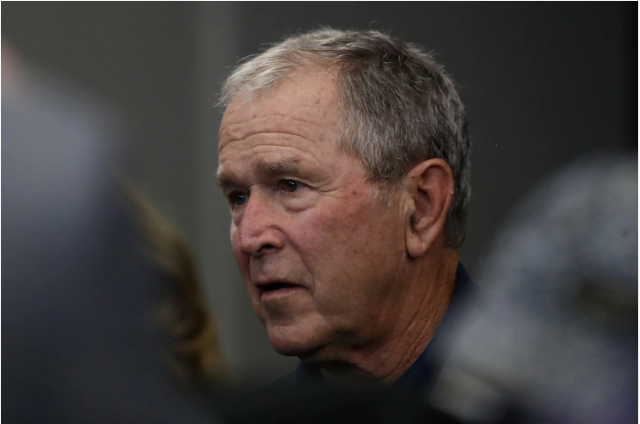
Describing himself as “anguished” by the death of George Floyd, who died more than a week ago after being suffocated under the knee of a white police officer, Bush urged white Americans to seek ways to support, listen and understand black Americans who still face “disturbing bigotry and exploitation.” (Getty Images)
The Washington Post
Former president George W. Bush addressed the nationwide protests in a solemn, yet hopeful statement Tuesday, commending the Americans demonstrating against racial injustice and criticizing those who try to silence them.
Bush closed his statement, which came a day after peaceful protesters were cleared by force to make way for President Trump to come outside, by pointing to a “better way.”
“There is a better way — the way of empathy, and shared commitment, and bold action, and a peace rooted in justice,” Bush said in the statement. “I am confident that together, Americans will choose the better way.”
Describing himself as “anguished” by the death of George Floyd, who died more than a week ago after being suffocated under the knee of a white police officer, Bush urged white Americans to seek ways to support, listen and understand black Americans who still face “disturbing bigotry and exploitation.”
The nation’s 43rd president’s statement does not mention Trump, but his call for compassion and unity presents a stark contrast to the current president’s more inflammatory rhetoric.
“The only way to see ourselves in a true light is to listen to the voices of so many who are hurting and grieving,” Bush said. “Those who set out to silence those voices do not understand the meaning of America — or how it becomes a better place.”
“We can only see the reality of America’s need by seeing it through the eyes of the threatened, oppressed, and disenfranchised,” he added.
Bush also seemed to offer a veiled criticism of the agressive stance taken by some police against protesters, saying it’s a strength when protesters, protected by responsible law enforcement, march for a better future.”
Biden will attend George Floyd’s funeral, family attorney says

U.S. presidential candidate Joe Biden bows his head in prayer during a visit to Bethel AME Church in Wilmington, Del., on June 1st. Biden is delivering a speech in Philadelphia, addressing “the civil unrest facing communities across America.” (AP photo)
An attorney for Floyd’s family told “PBS News Hour” on Tuesday that former vice president Joe Biden, the presumptive Democratic presidential nominee, is expected to attend Floyd’s funeral in Houston next week.
The family will also hold memorial services this week in Minnesota and North Carolina. A public viewing and formal funeral will follow in Houston.
“And we understand vice president Biden will be in attendance,” Ben Crump, the family’s attorney, said.
Watch: Biden blasts Trump’s ‘narcissism’ Addressing the ‘Unrest Across America‘
—
Related:
How to Make this Moment the Turning Point for Real Change: By Barack Obama
‘We’re sick of it’: Anger Over Police Killings Shatters US
Obama On George Floyd’s Death And The ‘Maddening’ Normalcy Of Racism
Join the conversation on Twitter and Facebook.

























